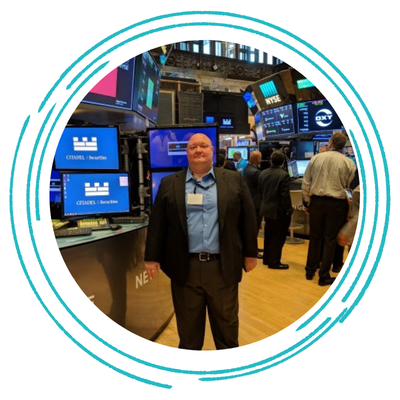Day 2: 15 October
8:00 am - 8:45 am
Registration
8:45 am - 9:00 am
Chairs opening remarks
A dynamic morning where the brightest minds from academia and the world’s leading quantitative finance teams unveil groundbreaking strategies and fresh innovations. This isn’t just a lecture — it’s a conversation. In the lead-up to the event, you’ll have the opportunity to submit your questions and steer the discussion, making sure the topics you care about are front and centre.
9:00 am - 9:30 am
The next frontier in Quant Finance: From Alpha models to autonomous market systems
Paul Bilokon -
CEO, Head Quant,
Thalesians
Over the past three decades, quantitative finance has evolved from handcrafted factor models to sophisticated machine learning–driven alpha generation. Yet the field remains constrained by a paradigm that treats models as isolated engines for signal extraction rather than integrated, adaptive decision-making entities.
In this talk, I will outline the research agenda that takes quant finance beyond alpha — towards autonomous market systems capable of perceiving, reasoning, and acting in dynamic market environments.
Drawing on my research, I will demonstrate how advances in AI, distributed systems, and stochastic control can be fused to create self-optimising, interpretable trading frameworks.
These systems not only learn in real time but also manage execution, risk, and portfolio construction as an integrated whole, closing the loop between prediction and action. The implications go beyond trading: autonomous market systems have the potential to reshape market microstructure, redefine the role of human oversight, and challenge our regulatory and ethical frameworks.
This is the next frontier, where the boundaries between quantitative research, AI, and market design dissolve.
9:30 am - 10:00 am
Machine Learning interpretability methods in Finance
Dr. Daniele Bianchi -
Associate Professor at the School of Economics and Finance,
Queen Mary, University of London
Overview objectives:
- Introducing the application of ML interpretability
- Highlight frameworks that ensure transparency and regulatory alignment in ML-driven strategies
- Examine academic research on explainable AI (XAI) models tailored to financial practical use cases and real-world industry examples
- Discuss the trade-off between model complexity and interpretability in alpha generation

Dr. Daniele Bianchi
Associate Professor at the School of Economics and FinanceQueen Mary, University of London

10:00 am - 10:40 am
Modelling prices from speculative markets: Bursting bubbles or deflating balloons?
Professor Andrew Harvey -
Professor of Econometrics, Faculty of Economics,
University of Cambridge
This session explores novel modelling approaches to speculative asset pricing, distinguishing between classic bubbles and more subtle "balloon-like" behaviour—characterized by rapid rises and gradual declines. Using high-frequency Bitcoin data, Andrew Harvey presents a series of score-driven and quasi score-driven models that integrate volatility, non-normality, and dynamic tail behaviour. The findings challenge traditional bubble narratives and offer practical tools for forecasting and risk modelling in speculative markets.
Overview objectives:
- Understand how score-driven models and time-varying tail indices improve the detection of bubble vs. balloon market dynamics.
- Learn how these models were applied to Bitcoin to identify and simulate locally explosive behaviour.
- Explore the implications for volatility modelling and density forecasting in financial markets with extreme price fluctuations.

Professor Andrew Harvey
Professor of Econometrics, Faculty of EconomicsUniversity of Cambridge

10:40 am - 11:00 am
PRESO: A Context-Engineering Based Knowledge Framework for Quantitative Finance
Haoxue Wang -
Quant,
Millennium
Demo Drive
11:05 am - 11:20 am Mobile App Performance and Web Insights solutionsSensor Tower is the leader in market insights, helping Investors measure the digital economy with best in class data that spans the mobile app, web, and digital advertising ecosystem. During this session, Yash Devalia, Sales Director at Sensor Tower, will overview Sensor Tower's Mobile App Insights solutions, now available Point in Time to ensure more reliable and consistent back tests. With Mobile App Performance and Advertising Insights, Investors can unlock download, revenue, and active user data, discover new investment opportunities, analyze mobile performance, and understand shifting market dynamics across the digital landscape.
Demo Drive led by: Yash Devalia, Sales Director, Sensor Tower
Booth: C8
Data, AI, and Applied Innovation Stage
11:30 am - 12:10 pm FIRESIDE CHAT: Risk and reward in the Commodities markets Oudom Dy - Head of Quantitative Research Commodities - Director, Natixis CIBSaeed Amen - Founder, Turnleaf Analytics
Paul Bilokon - CEO, Head Quant, Thalesians
The commodities market present unique opportunities and risks requiring specialised strategies and deep market insight.
- Explore the risk-return profile of private commodity investments like energy, metals, and agriculture
- Understand key challenges around pricing, liquidity, and operational risk
- Learn how investors and funds are accessing and managing exposure in the commodity markets
Data, AI, and Applied Innovation Stage
12:10 pm - 12:40 pm JOINT PRESENTATION: Systematic Investing in FX Options Markets: Beyond the VRP Francesco Pozzetti - Vice President, QIS Research, Deutsche BankCaio Natividade - Global Managing Director, Head of Quantitative Investment Solutions Research, Deutsche Bank
In this presentation, we’ll cover opportunities in currency options going well beyond volatility carry. FX options markets provide unique opportunities including trades in the correlation and forward start domain which the quant investor can harness systematically while limiting exposure to traditional risks.

Caio Natividade
Global Managing Director, Head of Quantitative Investment Solutions ResearchDeutsche Bank

Portfolio Optimization and Risk Management Stage
11:30 am - 12:10 pm PANEL: Portfolio Optimization in Practice - Balancing Agility, Stability, and Strategic Return Bruno Pajusco - Founder and CEO, Keridion CapitalArtur Sepp - Global Head of Investment Services Quant Group, LGT Bank
Siddharth Grover - Managing Director & Head of Quantitative Investment Strategy Product Development, BBVA Global Markets
Stephan Kessler - Global Head of Quant Research - MD, Morgan Stanley
Christian Putz - Founder and CEO, ARR Investment Partners
As markets become more volatile and data-driven, investment leaders must strike a delicate balance between front-office agility and back-office resilience—while unlocking the full potential of portfolio optimization. This panel explores how technology, structure, and process design can shape stronger investment outcomes.
Join this session to:
- Explore how technology, automation, and real-time data integration are reshaping the investment lifecycle
- Understand how to structure portfolios to maximize risk-adjusted return in uncertain markets
- Learn how to build robust, resilient, and continuously optimized investment processes
- Assess how much portfolio optimization truly improves the investment process - and where the untapped gains lie

Siddharth Grover
Managing Director & Head of Quantitative Investment Strategy Product DevelopmentBBVA Global Markets
Portfolio Optimization and Risk Management Stage
12:10 pm - 12:40 pm PRESENTATION: Leveraging Neuroscience to Optimize Brain Capital Emily Cook - Neuroscience-based Performance Coach and Founder, FOUND
QuantFusion Masterclass
11:30 am - 12:40 pm Masterclass: Understanding Behavioural Styles Ras Gohil - Senior Manager, Corporate Partnerships, Women in Banking & Finance (WIBF)Unlock the secret to better workplace communication and team performance.
Join us for an engaging workshop exploring how different behavioural styles impact professional relationships and team dynamics. You will discover practical strategies to enhance communication, improve collaboration, and create more effective working relationships.
What we will cover
- The Four Behavioural Styles: Understand Dominant/Direct, Influential/Interactive, Steady/Supportive, and Conscientious/Cautious approaches
- Communication Strategies: Learn how to adapt your communication style to connect effectively with colleagues, clients, and team members
- Team Building: Discover how to leverage different behavioural strengths and create balanced, high-performing teams
- Leadership Skills: Develop techniques to motivate and manage different personality types more effectively
Hosted Buyers Club
11:30 am - 12:30 pm Hosted Buyers ClubData, AI, and Applied Innovation Stage
1:40 pm - 2:20 pm PANEL: Systematic factor-based strategies in fixed income and FX Hamza Chaudhry - Fixed Income Quantitative Researcher, AllianceBernsteinJustin Xu - Head of Quant and AI Strategy, Millennium Global Investments Ltd.
Alexandra Billon - Global Head of Portfolio Analytics Group /Fixed Income, BlackRock
Saeed Amen - Founder, Turnleaf Analytics
In today’s data-driven market, fixed income and FX strategies are rapidly evolving so investment approaches must be reshaped:
- Explore how data analytics, machine learning, and alternative data are transforming fixed income and FX investment strategies
Panel questions:
- How can a bottom-up, factor-driven approach enhance alpha generation and risk management in fixed-income portfolios?
- What are the key challenges in identifying and applying systematic factors within diverse fixed-income asset classes?
- With quant factors, how do you set up portfolio construction?
- Can you explain, in your own words, the role of automation and AI in optimizing execution and managing risk in these traditionally more stable markets?
Data, AI, and Applied Innovation Stage
2:20 pm - 3:00 pm FIRESIDE CHAT: Innovating climate risk pricing: Bridging fundamental models and market dynamics in ESG investing Antonia Lim - CIO, Impact CubedDr Christopher Cormack - Associate Business Fellow, UK Centre for Greening Finance and Investment
Haili Liu - Head of Sustainability Investment Solutions, Entis
This session will explore the development of sophisticated climate risk models to tackle the economic challenges posed by climate change.
· What are the key challenges in integrating climate risk factors into traditional asset pricing models, and how can new financial instruments be developed to address these gaps?
· How can asset managers and hedge funds better align their strategies with sophisticated climate risk models rather than relying on simplistic ESG factor models?
· How can novel model concepts—such as fundamentals-based climate risk frameworks—reshape ESG investment strategies, and what opportunities do they unlock for alpha generation and risk hedging?

Dr Christopher Cormack
Associate Business FellowUK Centre for Greening Finance and Investment
Portfolio Optimization and Risk Management Stage
1:40 pm - 2:00 pm PANEL: Alpha generation from Signals to Strategy: Unlocking Alpha Through Data Innovation and Machine Learning Stephan Kessler - Global Head of Quant Research - MD, Morgan StanleyOverview: From Signals to Strategy: Unlocking Alpha through data innovation and machine learning
The explosion of data and advances in machine learning are transforming how quants identify and act on signals. This session delves into the practical techniques being used to drive alpha-from smarter signal extraction and model refinement to the strategic deployment of AI. We'll also explore how external macro and geopolitical factors subtly shape the datasets we rely on, and how leading firms are building adaptive models that account for this evolving landscape.
Key Questions:
· What are the most impactful techniques you’re using to extract signals from complex or unconventional datasets?
· How are you applying machine learning in a way that enhances—not obscures—strategic decision-making in alpha generation?
· In what ways do broader macro or geopolitical shifts manifest in the data you work with, and how do you factor that into your models?
Portfolio Optimization and Risk Management Stage
2:00 pm - 2:20 pm QUICK FIRESIDE CHAT INSIGHT: BUILDING MULTI-MANAGER PLATFORMS IN DIGITAL ASSETS Friedrich Herzog - Head of Research and Senior PM, Matrixport Asset Management AGWhen constructing multi-manager portfolios, what are the key principles or frameworks you look at to ensure diversification and resilience across different strategies?
Portfolio Optimization and Risk Management Stage
2:20 pm - 3:00 pm OFF THE RECORD FIRESIDE CHAT: Fixing the fracture: Integrating tech across the front, mid, and back office Vlad Mereuta - Head of Risk Engineering, Man GroupVincenzo Pota - Data Scientist & Director, Barclays Investment Bank
Andrius Markvaldas - Senior System Engineer, VAST Data
This chat will explore the challenges, opportunities, and lessons learned in integrating technology and data infrastructure across the front, mid, and back-office functions in quantitative finance - with perspectives from both engineering and data users.
The session will examine how to break silos, streamline workflows, and improve the usability and consistency of data across the trade lifecycle.
Intro insight:
· Brief overview of how the front, mid, and back offices have traditionally operated in silos.
- Why fragmentation leads to latency, reconciliation errors, inconsistent datasets, and missed alpha opportunities.
- How quant-driven organizations are uniquely positioned to benefit from tighter integration.
From the Engineering Perspective:
From a systems design point of view, what’s been the hardest part of aligning front-office speed with back-office stability?
From the Data User Perspective: Quality, Access, and Context
How often are quant models or risk signals impacted by incomplete or misaligned data from mid or back office?
Lessons Learned Across Front, Mid, and Back Office
What was one turning point in getting front-to-back integration right in your organization?
The Integration Frontier: What’s Next?
· What an ideal front-to-back data architecture looks like in 2025+.
· Explore the trade-offs between speed, control, and compliance in trading operations
QuantFusion (Masterclass/Workshop)
1:40 pm - 3:30 pm Beyond Backtest: Stress-Testing Quant strategies for regime shifts and fragility Paul White - CEO and Co-Founder, Quantbot TechnologiesTom Crimi - Chief Technology Officer, Quantbot
Overview:
This advanced, interactive session dives into building robust strategies that survive changing regimes, liquidity shocks, and structural breaks. Participants will work in peer teams to reverse-engineer failure points in popular strategy types (e.g. momentum, stat arb, macro), then apply alternative risk frameworks and synthetic data stress-testing to strengthen model resilience.
Structure:
Part 1: Failure Mode Breakdown
A lead quant shows real examples of how well-performing strategies break during volatility spikes, macro shifts, or data leakage
Part 2: Group Diagnostic Labs
Groups are assigned different strategy types with embedded weaknesses; their task is to identify fragilities and propose mitigations using noise injection, adversarial scenarios, or market regime labeling
Part 3: Cross-Team Stress Test
Teams test each other’s improved strategies under stress scenarios (e.g., flash crash, rate shock, liquidity freeze)
Part 4: Wrap-up Discussion
Best practices in scenario generation, model robustness, and beyond-traditional VaR approaches
Takeaways:
- Advanced strategy diagnostics and regime detection
- Adversarial testing techniques and synthetic market scenario building
- Collaborative critique and resilient model innovation
Hosted Buyers Club
1:30 pm - 3:00 pm Hosted Buyers Club
3:00 pm - 3:30 pm
PANEL DISCUSSION: Beyond the Paycheck: Building and keeping world-class quant talent
Birthe Mester -
CEO,
Culture Dividend
Nicky King - Head of Corporate Partnerships, Women in Banking & Finance
Emily Cook - Neuroscience-based Performance Coach and Founder, FOUND
Dr. Joo Hee Lee - Consultant, CFA Institute
In the ultra-competitive landscape of quantitative finance, top talent is the most valuable (and volatile) asset. But what truly makes a quant stay? In this session, senior leaders share how they’ve built high-performing, research-led teams—without relying solely on compensation. We’ll explore strategies to recruit exceptional minds, assess career pathways for existing team members, and create a culture where quants thrive long-term.
Through a blend of quant-industry insights and lessons from leaders, this session will challenge firms to think beyond salaries and bonuses and toward what actually drives loyalty, innovation, and performance.
Discussion Points:
· Talent without turnover: What Big Tech can teach quant firms about cultivating belonging, purpose, and professional growth
· Career architecture for quants: How to define and communicate clear development pathways for research, trading, and engineering roles
· Why people really leave: Exploring the impact of team dynamics, leadership, flexibility, and legacy tech on retention
· Hiring with intention: Balancing technical excellence with long-term culture fit when recruiting into high-performance environments







































